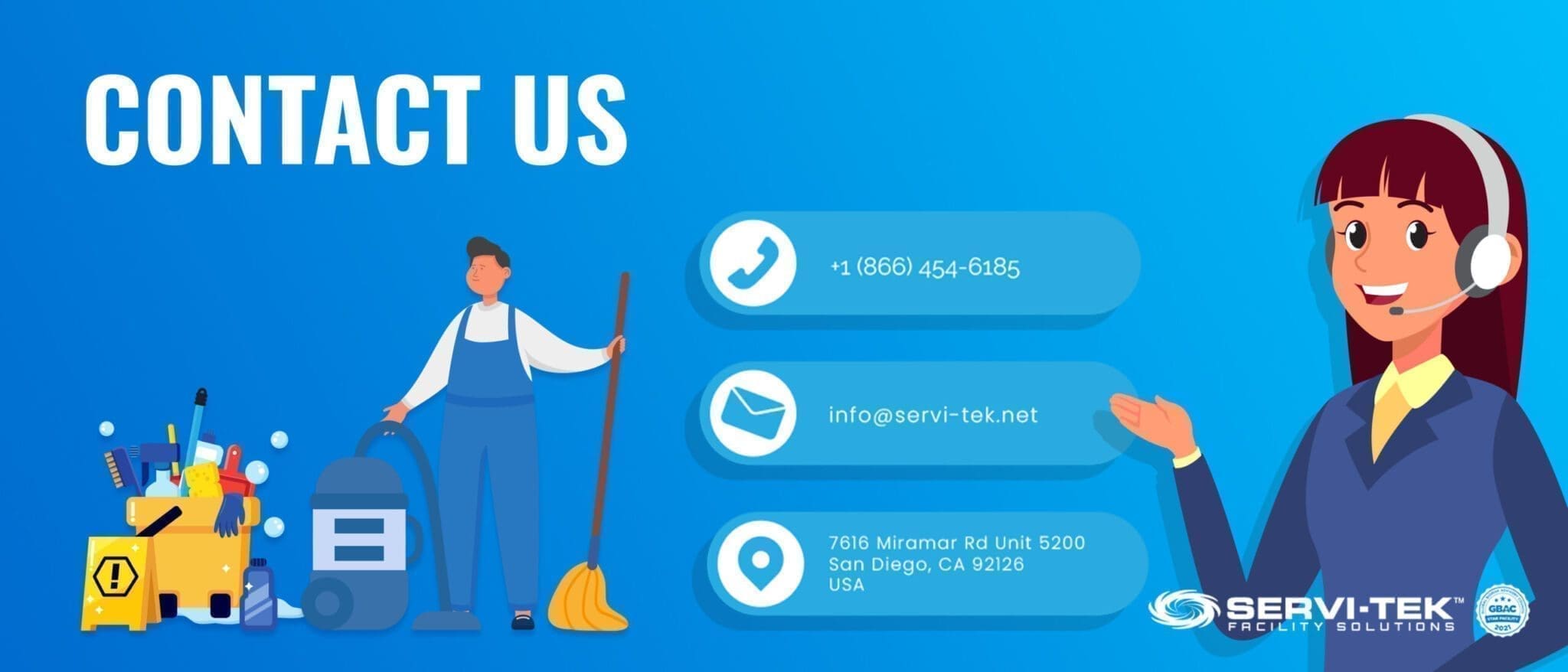
Health care is what every janitorial staff is involved in. However, your healthcare cleaning services go a step further in protecting your employees and patients.
This is particularly relevant in today’s Covid-19 times. It is the efforts of your medical facility or medical office cleaning service that prevents and manages the spread of coronavirus, other pathogens, and Healthcare-associated infections (HAI).
Most germs get transferred from counters, chairs, tables, and other commonly used surfaces in medical facilities. In a healthcare facility, there are several opportunities for infections.
This is because of the presence of bacteria, viruses, and other germs.
Medical cleaning services can go a long way in infection prevention and control even though most healthcare facilities have a way of preventing the spread of germs and pathogens.
Why Do Healthcare Facilities Require Extra Cleaning?
The last thing a patient needs after visiting a hospital, physician’s office, or medical clinic is to fall sick.
Healthcare facilities without effective commercial cleaning services can turn into a hub for virus and bacteria spread.
Every 1 in 20 patients contracts some sort of infection after visiting a medical facility as per data gathered by the Centers for Disease Control and Prevention.
Disinfection services are a must with numerous healthcare providers treating and seeing patients daily. OSHA has set strict cleaning standards for all medical facilities for this reason.
In fact, medical office cleaning services are a requirement if a healthcare facility doesn’t want to be slapped with fines because of not being aware of the right cleaning protocols or not being in compliance.
How to Clean and Disinfect Your Healthcare Facility
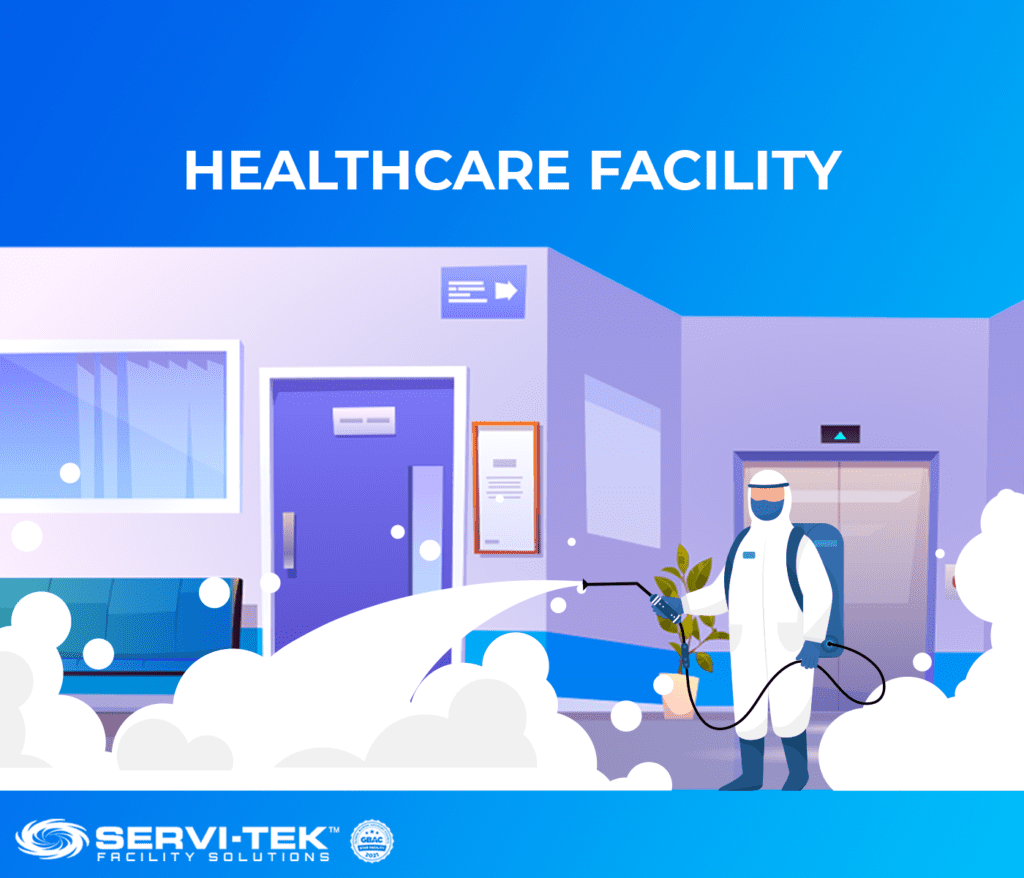
All janitorial services will come up with a plan to clean and disinfect various areas in a medical facility, such as the restrooms, doctors’ offices, employees’ break-rooms, surgery centers, outpatient facility, dental offices, dialysis centers, exam room, labs, and lobby among others.
The plan will identify and address basic EPA standards, such as carpet cleaning, maintaining cleanliness, preventing cross-contamination, and occupational safety among others.
The plan should also include ways of disinfecting different surfaces for infection control and disease control.
This is when you should also consider the type of solvents, cleaning solutions, disinfectants, and PPE to use.
Green cleaning solutions for a smaller carbon footprint. Health administration should ensure their cleaning service reviews green clean options.
The next step is to implement the plan and to follow all guidelines listed.
It is important to continuously maintain and revise as well. Routine cleaning and disinfection should be carried out using appropriate PPE and disinfectants. In fact, surfaces with frequent handling should be disinfected multiple times during the same day.
Healthcare Disinfectant: Cleaning Vs. Disinfection
There are two main components of healthcare commercial cleaning as per CDC guidelines – cleaning and disinfecting.
Healthcare providers need to ensure that their medical facility cleaning services understand these standards laid down by the CDC as well as the Environmental Protection Agency (EPA).
Cleaning refers to the removal of visible dirt, organic matter, and oil particles among others through machine or hand. Cleaning is done to ensure germs are not left on the surface to thrive.
The use of microfiber cloth is often recommended to carry out cleaning. Disinfection is similar to sterilization. It is carried out to remove microorganisms and other disease-causing pathogens.
What Are Some Best Practices To Follow When Selecting A Commercial Cleaning Service Provider For Your Healthcare Facility?
There are numerous medical cleaning services out there. You should lookout for a company that can offer the following:
1. Best Cleaning Practices
Healthcare facilities are where people go when they want to feel better, not sicker.
The commercial cleaning company that you choose should assess your facility’s needs and create proper techniques for cleaning, disinfecting, and removing dirt and other pathogens from all rooms.
They should take care to sanitize your healthcare facility completely and prevent cross-contamination and, most importantly, have experience in providing contract services for such medical facilities.
2. Training/Procedures
You don’t want to place your trust in untrained or inexperienced service providers.
Cleaning as a field has limited barriers to entry. You need to steer clear of medical cleaning facilities that are knowledgeable or do not invest in training their janitorial staff.
The company should know about the latest developments and advancements in clean technology. This will ensure optimal results for your patients and employees.
3. Communication
Healthcare cleaning services should have open channels of communication.
They should listen to your suggestions and complaints.
They should also be motivated enough to work upon them. All of your concerns should be addressed as soon as possible.
Your cleaning service provider should be considered your active business partner.
Steps To Creating A Safer Healthcare Facility
These are a few steps that can help ensure your healthcare facility stays clean, sanitized, and increase protection against Covid-19.
- Practice frequent and routine cleaning before disinfecting
- Give high priority to high traffic areas
- Disinfect using an EPA-certified product meant specifically for preventing the spread of coronavirus; often to referred to as List N. Make sure to follow all instructions on the product for effective and safe use.
- Ensure the cleaning staff has appropriate protective gear in the form of gloves and masks
Healthcare Cleaning Checklist for Preventing Spread of Coronavirus
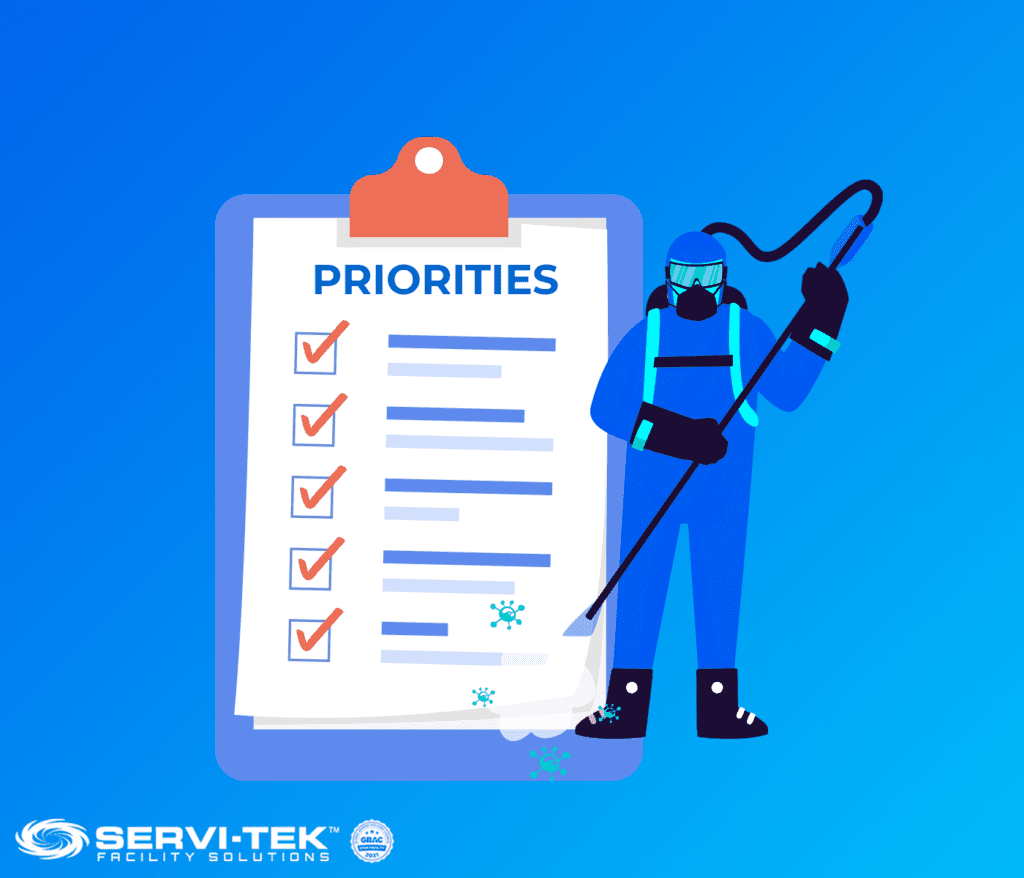
Healthcare facilities have multiple areas that need to be addressed differently.
This healthcare cleaning checklist identifies the challenges and ensures that nothing is missed.
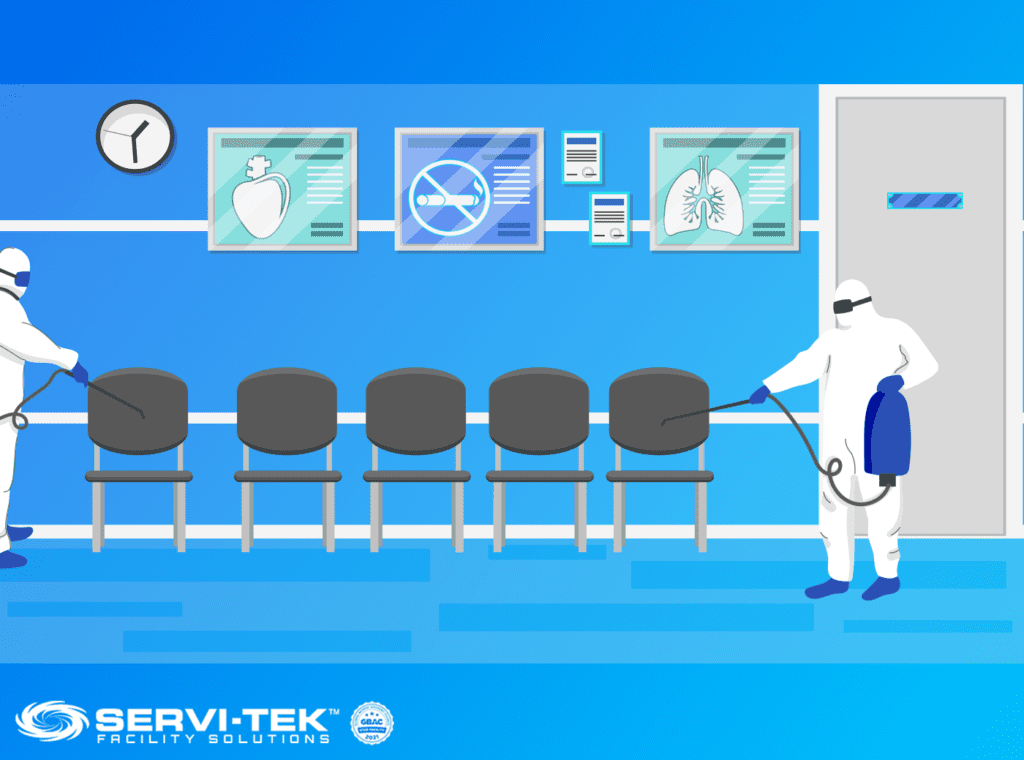
Communal areas for employees and patients
- Identify high-traffic areas, such as meeting rooms, lobby, and cafeteria
- Clean all surfaces
- Disinfect all surfaces
Areas frequented by patients
- Frequently clean and disinfect surfaces, particularly between each patient care episode
- Pay special attention to surfaces touched by patients
- Take care of surfaces that may have been exposed to respiratory droplets immediately
- Instill hand hygiene approach in all employees
Inpatient care
- Routinely clean and disinfect frequently touched surfaces
- Use a disinfectant more often in high traffic or high-intensity areas, such as outpatient areas or ICU
- Clean and disinfect your medical equipment
- Clean and disinfect all surfaces that may have been exposed to saliva or other respiratory droplets
- Don’t hesitate in carrying out a terminal cleaning if the area has been severely exposed to germs
How to Clean and Disinfect Medical Devices
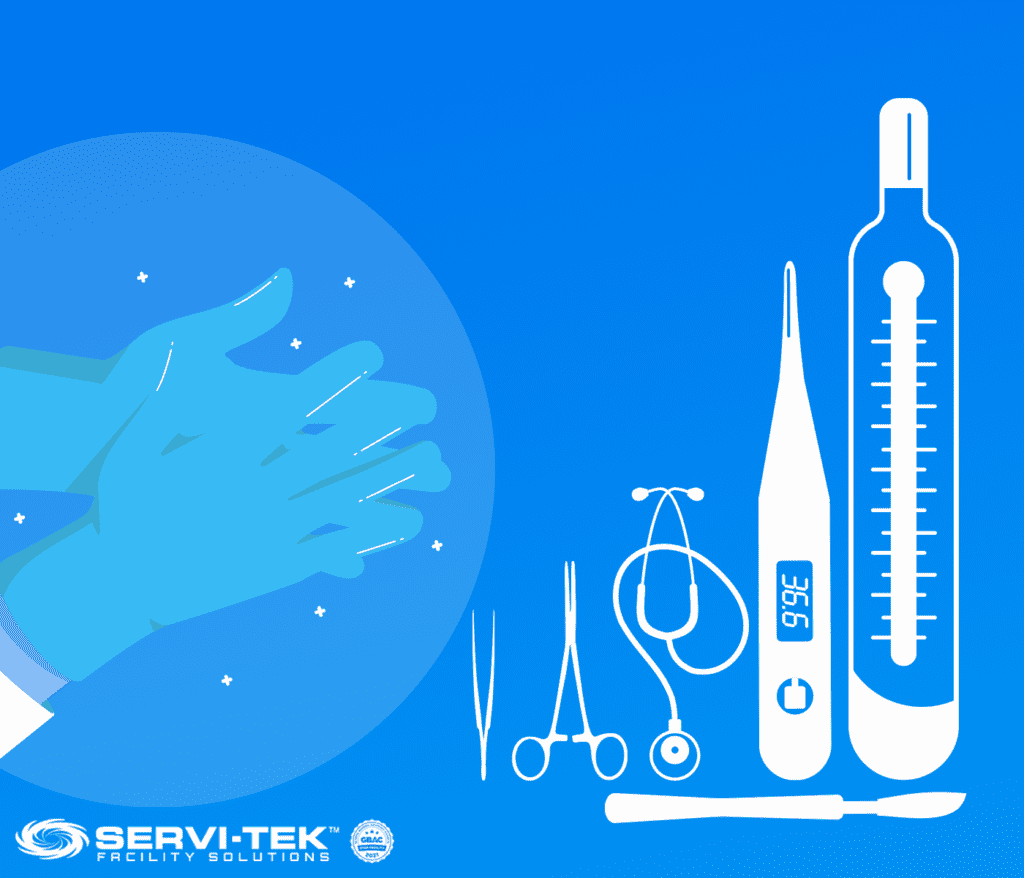
Medical equipment sterilization is an important component of modern medical care.
This is especially true when the spread of coronavirus is still a high risk. Medical devices involve everything from bandages and syringes to surgical tools.
You should make use of medical equipment only after cleaning and disinfecting it properly to ensure the safety of your employees and patients.
Effective and thorough cleaning is vital for regularly used medical devices.
This is necessary for avoiding the possibility of disease spread or germ spread from patient to patient. Healthcare facilities should have a plan in place to prevent the spread of HAIs.
This is the CDC recommended way of cleaning medical devices and other equipment:
- Cleaning with soap and water should never be skipped. This is necessary even if you are disinfecting the device.
- Use liquid chemicals to disinfect the device.
- Sterilization is necessary to kill all disease-causing pathogens and to eliminate the possibility of transmissible agents, such as spores and bacteria.
The extent of disinfection and sterilization depends on the medical device and the way it was used.
Certain equipment requires a higher level of sterilization while others can be effectively sanitized with low-level sterilization as well.
There are three categories of objects:
- Critical objects include surgical instruments that touch sterile tissue
- Semi-critical objects include the devices that come in touch with mucous membranes, such as endoscopes
- Non-critical objects only touch intact skin, such as stethoscopes
Identifying Your Healthcare Cleaning Needs
Your healthcare facility deserves the best methods of cleaning, disinfection and if required, sterilization.
The team at Servi-Tek Facility Solutions works hard to remove dirt, organic matter, and other pathogens from floors and various other surfaces throughout the facility.
This helps in reducing or eliminating the chances of secondary infections.
We partner so your facility remains open and operating.
At Servi-Tek, we understand the importance of cleanliness and sanitization in a healthcare facility and possess the industry-specific focus and experience to provide a sanitary environment for your employees and patients.
This is why we follow regulatory standards laid down by OSHA, AAAHC, and the Joint Commission on Accreditation of Healthcare Organizations (JCAHO) among other local and state agencies.
Learn more about how we can create a mutually beneficial medical workplace by calling us at (866) 454-6185.



